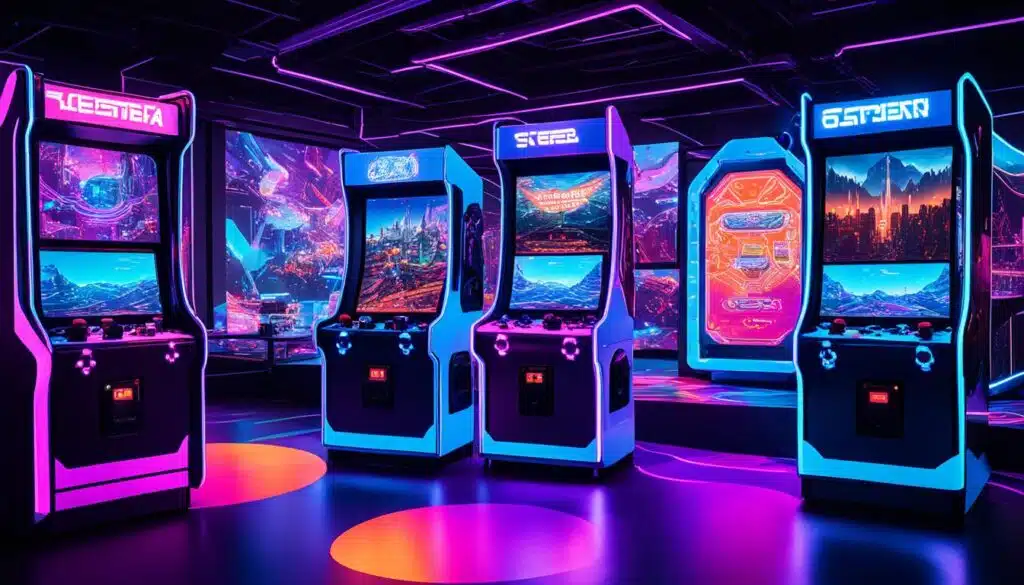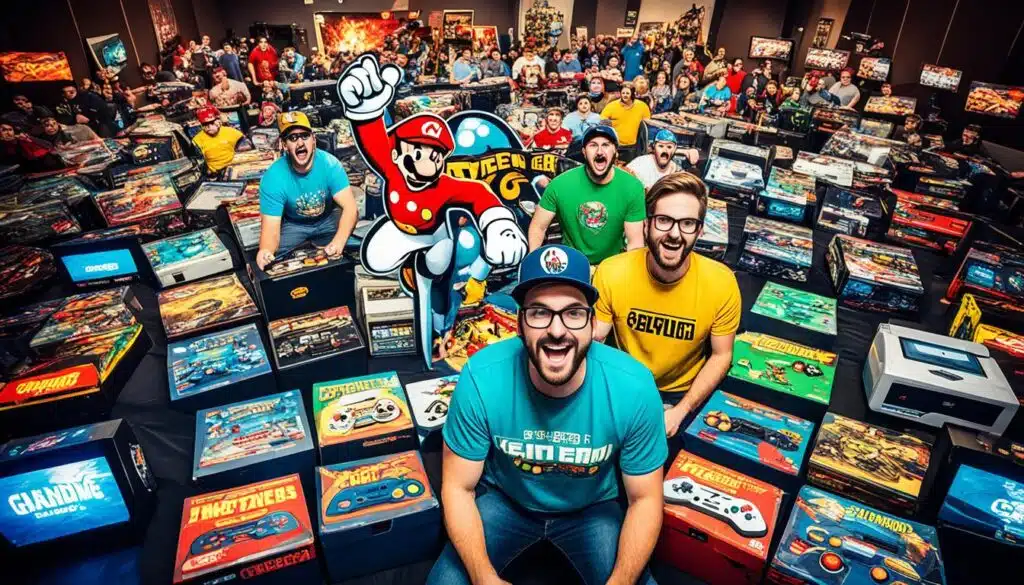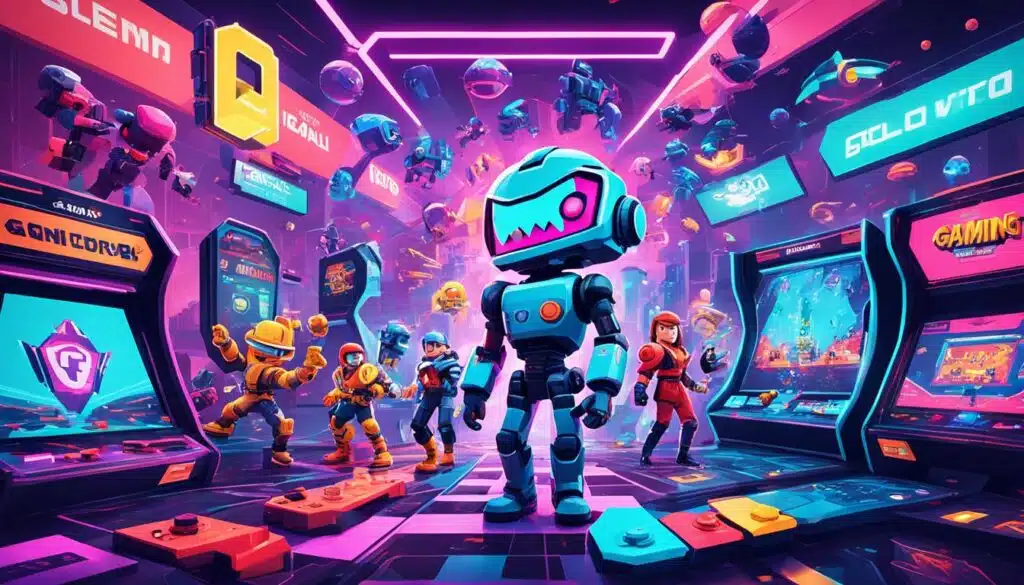Retro Gaming Hype Reaching New Levels industry is experiencing a surge in popularity as nostalgic gamers and new enthusiasts alike fuel a burgeoning appreciation for classic titles. With the market projected to surpass $300 billion in the next few years, it’s evident that the hype for retro gaming is reaching new heights. This resurgence of interest is giving rise to a vintage video game craze and a renaissance of nostalgic gaming.
Key Takeaways
- Retro gaming is experiencing a surge in popularity, driven by nostalgic gamers and new enthusiasts.
- The market for retro gaming is projected to surpass $300 billion in the next few years.
- The resurgence of interest in retro gaming is fueling a vintage video game craze.
- There is a renaissance of nostalgic gaming as gamers rediscover classic titles.
- The hype surrounding retro gaming is reaching new levels, creating excitement in the industry.
The Growth of the Gaming Industry
The gaming industry is a massive market that has been steadily growing over the years. In 2019, the global gaming market was valued at $152 billion, and by 2021, it had already reached $214 billion. This substantial growth is indicative of the industry’s potential and its ability to generate significant value.
Experts predict that the global gaming market will continue to flourish, surpassing $300 billion by 2026. This projection positions the gaming market as bigger than all other forms of entertainment, further solidifying its dominance in the entertainment industry.
This rapid growth in the gaming market presents a prime opportunity for value creation and investment in gaming companies. The potential for substantial returns on investment is evident, making the gaming industry an appealing sector for entrepreneurs and investors alike.
Evolution of Games as a Platform
Games have undergone a significant transformation, evolving from standalone experiences to dynamic platforms that continually adapt and improve. Unlike in the past, where game development ended with the release of a finished product, developers now engage in constant updates, analyzing user behavior, and optimizing their games to provide the best possible experience for players.
Live operations have become a cornerstone of the gaming industry, enabling developers to deliver personalized and engaging experiences to players. By leveraging live operations, game developers can respond to player feedback in real-time, address issues promptly, and introduce new content to keep players engaged and excited.
“Games as a platform” refers to this ongoing cycle of updates, optimization, and engagement, wherein games continue to grow and evolve long after their initial release.
This evolution of games into a living, breathing platform showcases a profound understanding of user psychology. Game developers study player behavior, preferences, and engagement patterns to gain insights that inform game updates, adjustments, and new features. By tailoring the gaming experience to individual players, developers can foster a deeper connection and enhance user satisfaction.
The significance of live operations in game development
Live operations play a prominent role in the gaming industry, as they serve as a driving force behind consistent player engagement and retention. This approach is characterized by the continuous release of new features, events, and content within the game. By providing fresh and exciting experiences, game developers keep players invested and motivated to keep playing.
Here’s an example illustrating the impact of live operations:
| Game Title | Release Date | Number of Updates | Active Playerbase |
|---|---|---|---|
| Game X | August 2019 | 37 | 5 million |
| Game Y | November 2020 | 8 | 2.5 million |
| Game Z | February 2021 | 20 | 4 million |
As the table illustrates, games that receive constant updates and engage in live operations tend to have larger active player bases. By delivering ongoing content and experiences, game developers can create a sense of anticipation and excitement, which keeps players coming back for more.
Through live operations, developers can also introduce limited-time events, collaborations, and community engagement activities that further enhance the gaming experience. These efforts foster a sense of community among players and create a shared excitement for what’s to come.

Furthermore, live operations benefit both players and developers. Players receive regular content updates and improvements, ensuring their gaming experience remains fresh and stimulating. Developers, on the other hand, gain valuable insights into player behavior and preferences, allowing them to fine-tune their games based on user feedback and data analysis.
In conclusion, games as platforms offer a unique opportunity for innovation and growth within the gaming industry. Through constant updates, live operations, and a deep understanding of user psychology, games can deliver personalized, engaging experiences to players, keeping them invested and excited for what’s to come.
Data-Driven Live Platforms
Data-driven optimization is a crucial component of the gaming industry. Game developers utilize data science to continuously enhance their games, delivering a more enjoyable, engaging, and exciting experience for players. By analyzing user feedback and behavioral data, developers make informed decisions regarding updates, content additions, and live events. This process of constant improvement sets gaming apart from other industries, ensuring a better user experience and keeping players coming back for more.
Benefits of Data-Driven Optimization
Implementing data-driven optimization yields several benefits for game developers and players alike:
- Improved Gameplay: By analyzing user feedback and behavior, developers gain insights into what aspects of the game are working well and what can be enhanced, resulting in improved gameplay mechanics, balance, and overall enjoyment.
- Personalized Experiences: Utilizing data allows developers to tailor experiences to individual players, delivering content and challenges based on player preferences and behaviors. This customization enhances player engagement and satisfaction.
- Timely Updates: Through data analysis, developers can identify areas that require updates or adjustments, ensuring that players receive timely bug fixes, balance changes, and new content to keep the game fresh and exciting.
- Balanced Monetization: Data-driven optimization helps developers strike a balance between providing enjoyable gameplay experiences and monetizing their games effectively. By understanding player behavior, developers can implement monetization strategies that enhance the game experience rather than disrupt it.
- Competitive Edge: Constantly improving and optimizing based on data allows developers to stay ahead of the competition, delivering a superior gaming experience that keeps players engaged and loyal.
User Feedback: A Valuable Resource
User feedback plays a crucial role in data-driven optimization. Developers actively encourage players to provide feedback, whether through in-game surveys, forums, or dedicated feedback channels. This direct input from the gaming community provides valuable insights into players’ likes, dislikes, and suggestions for improvement.
“Player feedback is invaluable for game developers. It helps us understand what the players want and allows us to continuously improve and refine our games.” – Rachel Johnson, Lead Game Developer at PixelSoft Games
The effectiveness of user feedback is further enhanced through the use of advanced analytics tools, which allow developers to gain deeper insights from collected data. This data-driven approach marries player opinions with quantitative analysis, providing developers with a comprehensive understanding of players’ needs and preferences.
By using data-driven optimization and leveraging the power of user feedback, game developers can ensure that their games are constantly evolving and delivering the best possible experiences for players.
Generative AI in Gaming
The integration of generative AI in gaming is revolutionizing the game creation process. By harnessing the power of AI, game developers can now generate unique in-game assets and scenes, making content creation more efficient and cost-effective. This groundbreaking technology automates the generation of personalized objects and scenes, resulting in game worlds that are more immersive, interesting, and engaging for players.
Generative AI enables game developers to accelerate the pace of game development by streamlining content creation. With AI-powered tools, developers can quickly create a wide variety of assets and scenes, saving valuable time and resources. This allows for faster game releases and more frequent content updates, keeping players engaged and excited for what’s to come.
The Benefits of Generative AI in Gaming
- Cost-effective content generation: Generative AI reduces the need for manual content creation, lowering production costs and increasing efficiency.
- Time-saving: AI-powered tools can generate assets and scenes at a significantly faster rate, speeding up the game development process.
- Uniqueness: With generative AI, game developers can create one-of-a-kind objects and scenes, providing players with fresh and distinctive experiences in each playthrough.
- Enhanced creativity: By automating certain aspects of game creation, developers have more time and creative freedom to focus on designing unique gameplay mechanics and narrative elements.
The table below highlights the advantages of using generative AI in gaming:
| Advantages of Generative AI in Gaming |
|---|
| Cost-effective content generation |
| Time-saving |
| Uniqueness |
| Enhanced creativity |
With generative AI, game developers have a powerful tool that not only reduces costs and saves time but also enhances creativity and provides players with unique and engaging experiences. As the gaming industry continues to evolve, the integration of generative AI will undoubtedly play a crucial role in shaping the future of game development.

The Impact of Hype in Gaming
Hype plays a significant role in the gaming industry, fueling anticipation and excitement for upcoming games. The reasonable hype surrounding the release of a highly anticipated title creates a sense of expectation and joy among gamers. The anticipation of experiencing new gameplay mechanics, immersive storytelling, or stunning graphics can elevate the excitement levels to new heights.
While it’s important to approach game expectations with a level of skepticism and read reviews before making a purchase, the process of anticipating a game and imagining the fun it will bring is an integral part of the gaming experience. The joy of anticipation often outweighs any potential disappointment, as it allows gamers to immerse themselves in the possibilities and engage with the game prior to its release.
The gaming community thrives on discussing and speculating about upcoming releases, fostering a sense of camaraderie and shared excitement. Whether it’s through online forums, social media, or gaming conventions, gamers come together to share their expectations and predictions, building a sense of community around the joy of anticipation.
“The hype surrounding a new game release allows gamers to indulge in the thrill of anticipation, creating a shared experience among enthusiasts. It’s a time of speculation, excitement, and a collective countdown to the moment when the game finally becomes available.”
The impact of hype goes beyond the release of a game. Developers and publishers often utilize hype as a marketing strategy, leveraging trailers, teasers, and exclusive gameplay reveals to generate buzz and drive pre-orders. The carefully crafted marketing campaigns build anticipation and contribute to the overall success of the game upon release.
Overall, the impact of hype in gaming is undeniable. It sparks anticipation, generates excitement, and fosters a sense of community among gamers. The joy of anticipation is an integral part of the gaming experience, enhancing the overall enjoyment of exploring new virtual worlds and engaging in immersive gameplay.

The Joy of Anticipation
Anticipating the release of a highly anticipated game brings a unique sense of joy to gamers. The excitement and anticipation fuel the imagination, allowing players to envision the experiences they will have in the game. The joy of anticipation often leads to lively discussions, speculation, and a sense of camaraderie among gamers, creating memorable moments and building excitement for the gaming community.
The Historical Relationship Between Humans and AI in Gaming
The history of AI in gaming is marked by significant milestones that have shaped the relationship between humans and artificial intelligence. One of the most notable events occurred in 1997, when IBM’s DeepBlue defeated chess grandmaster Garry Kasparov, marking a turning point in the integration of AI in gaming.
In-game intelligence has always been a core aspect of gaming, even from its early days. Game developers have been creating AI opponents and non-playable characters (NPCs) with varying levels of intelligence and behavior to provide engaging and challenging gaming experiences. These AI entities are programmed to mimic human-like decision-making processes and reactions.
Over the years, the evolution of AI in gaming has brought about more sophisticated algorithms and techniques. Deep learning models, for example, have been leveraged to enhance the intelligence and adaptability of AI opponents. By analyzing vast amounts of data and applying deep learning algorithms, game developers can create opponents that learn from player behavior and adjust their strategies accordingly.

“In-game intelligence has always been a core aspect of gaming, even from its early days.”
An Example of In-Game Intelligence: Chess AI
Chess AI serves as a prime example of the historical relationship between humans and AI in gaming. In the world of chess, AI opponents have been challenging players for decades. AI-powered chess engines have become incredibly advanced, capable of analyzing countless moves in seconds and providing formidable competition for even the most skilled human players.
In 1997, DeepBlue’s victory over Garry Kasparov was a groundbreaking moment that captured the world’s attention. It was the first time a computer program defeated a reigning world chess champion, showcasing the potential of AI in gaming and raising questions about the future of human-machine competition.
Since then, chess AI has continued to evolve and improve. Today, players can compete against AI opponents of various skill levels, ranging from beginner-level AI for new players to superhuman-level AI for experienced chess enthusiasts. AI-powered chess engines have become indispensable training and analysis tools for chess players of all levels.
The Future of AI in Gaming
The historical relationship between humans and AI in gaming demonstrates the ongoing progress and potential of AI in shaping the gaming landscape. As AI technologies continue to advance, we can expect to see even more intelligent and immersive gaming experiences.
Developers will likely leverage AI to create increasingly realistic and human-like AI opponents, leading to more challenging and engaging gameplay. Additionally, AI can contribute to adaptive game systems that tailor experiences based on each player’s unique preferences and behaviors.
With the integration of AI, the gaming industry stands on the cusp of a new era, where intelligent virtual entities enhance and enrich the gaming experience. As technology progresses, the boundaries between human and AI gameplay become blurred, enhancing the joy and excitement of gaming for players worldwide.
Deep Learning Models and Game Design
Deep learning models have revolutionized game design, bringing new levels of sophistication to the implementation of AI in games. Developers now have the ability to create in-game intelligence that is more complex than ever before, thanks to advancements in deep learning algorithms and behavioral decision-trees.
One common method used in game design to create challenging opponents is the use of behavioral decision-trees. These decision-trees allow AI-controlled characters to make intelligent and contextual choices based on a set of predefined rules and conditions. By using decision-trees, game developers can create opponents that exhibit realistic and adaptive behaviors, enhancing the overall gameplay experience.
The integration of deep learning algorithms in game design has also led to the development of goal-oriented action planning. This approach involves training AI agents to plan and execute sequences of actions based on defined objectives and environmental factors. With goal-oriented action planning, game developers can create opponents that exhibit strategic decision-making and adapt their behaviors dynamically in response to player actions.
Deep learning models in game design rely heavily on the use of large in-game databases that capture player behavior and preferences. These databases allow for the analysis of vast amounts of data, enabling AI-controlled characters to make informed decisions based on player actions. By analyzing player behavior, the AI can learn patterns and trends, further enhancing the in-game intelligence and creating more immersive and challenging gameplay experiences.
retro, hype reaches, new games, God of War Ragnarok, gameplay, NES, DLC, lot of games, mechanics, Uncharted, I’m, dev, PS4, boss, get hyped, PC, first one, looking forward, value games, Xbox, PS2, transcript, JavaScript is disabled, please enable JavaScript, browser before proceeding, SNES, retro games, trend, gen, better experience, games coming, PS5, franchise, original Armored Core, Resident Evil, Star, common games, height, games also, best games, I’ve played, it will, AAA game, OP, need to see, console, studio, entry, YouTube channel, open world, good as the original, Witcher 3, Legend of Zelda, suck, around the corner, anticipate, insanely, Dogma 2, gameplay trailer, amount of content, wish, trilogy, Witcher 2, anticipation, 2020, high production value, rarely get, could still, Horizon Forbidden West, game ever, Nintendo, TLOU, PlayStation, Dead Space, PSP, RPGs, nostalgia, forefront, demo, gameplay mechanics, GTA V, beta, purchase, I’m sure, trope, judge, dominate, single game, RPG
The integration of AI and deep learning models in game design has pushed the boundaries of gameplay, creating new challenges and opportunities for players. The use of decision-trees, goal-oriented action planning, and large in-game databases has paved the way for more intelligent and engaging opponents, elevating the overall gaming experience.

The Benefits of Deep Learning in Game Design
Deep learning in game design offers several benefits that enhance the overall gaming experience:
- Challenging Opponents: Through the use of behavioral decision-trees and goal-oriented action planning, AI-controlled opponents can provide players with challenging and adaptive gameplay experiences.
- Immersive Environments: Deep learning models enable the generation of realistic and dynamic game worlds, enhancing immersion and player engagement.
- Personalized Gameplay: By analyzing player behavior, deep learning algorithms can customize the gameplay experience, providing a unique and tailored experience for each player.
- Efficient Content Creation: Deep learning models can automate the generation of in-game assets, reducing the time and cost associated with content creation.
With the continued advancement of deep learning models and AI technology, the possibilities for game design are expanding. The integration of deep learning in game design holds immense potential for creating more immersive, intelligent, and enjoyable gaming experiences for players.
Also Read:- Master Retro Game Streaming Tips For Classic Fun
Conclusion
The retro gaming industry is currently experiencing unprecedented levels of hype, fueled by the continuous growth of the gaming market and the evolution of game design. This surge in popularity has paved the way for exciting advancements in both content creation and in-game intelligence, thanks to the integration of generative AI and deep learning models.
Looking into the future, it is evident that AI will continue to play a significant role in enhancing gameplay experiences and pushing the boundaries of what is possible in the gaming world. The potential of AI in gaming is vast, and it holds immense promise for retro gaming enthusiasts and new gamers alike.
With the use of generative AI, game developers can create cost-effective content and automate the generation of unique in-game assets and scenes, making retro game worlds even more captivating. Additionally, the integration of deep learning models has revolutionized game design, allowing for more complex in-game intelligence, challenging opponents, and decision-making processes based on player behavior.
As the hype for retro gaming continues to soar, the future of the industry looks incredibly promising. The combination of nostalgia and technological advancements in AI has created an exciting environment for gamers to relive classic titles and explore new gaming experiences. From content creation to in-game intelligence, the potential of AI in gaming is set to enhance and redefine the gaming landscape for years to come.
FAQs
Q: What is the current hype around retro gaming?
A: The retro gaming hype is reaching new levels, with popular titles like Zelda and NES making a comeback.
Q: Can you provide some examples of retro games generating excitement?
A: Games such as the original Armored Core, Resident Evil, and Legend of Zelda are among the common games driving the hype.
Q: What upcoming games are contributing to the excitement in the retro gaming community?
A: Titles like Elden Ring, Dogma 2, and God of War Ragnarok are highly anticipated among retro gamers.
Q: How important is the open-world aspect in retro gaming?
A: Open-world games like the first Zelda and original Armored Core offer a different gaming experience for retro enthusiasts.
Q: Is there a demand for sequels or remakes of classic retro games?
A: Yes, there is a significant demand for sequels or remakes of classic retro games like NES, SNES, and PS2 titles.
Q: Are there any popular gaming studios known for developing retro-style games?
A: Studios like IM, Dev, and Star are renowned for creating retro-inspired games that resonate with nostalgic gamers.
Q: How can I stay updated on the latest retro gaming news and releases?
A: You can follow gaming channels on YouTube or subscribe to gaming websites for regular updates on retro games and announcements.
Source Links
- https://www.nfx.com/post/the-next-era-of-gaming-generative-ai
- https://www.ign.com/articles/2015/01/31/opinion-hype-isnt-always-a-bad-thing-hype-is-hope
- https://www.linkedin.com/pulse/ai-gaming-hype-reality-tiago-teixeira-correia-nengf
